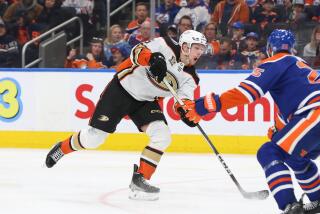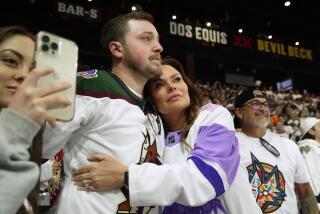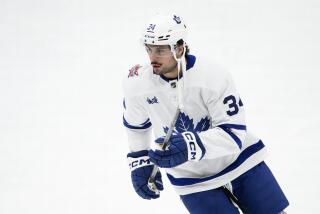NHL Comes Back but Still Has Issues
- Share via
The NHL has come back from the oblivion of a lockout with an exciting, faster game and playoff pursuits that will carry into today’s final games.
Scoring has increased dramatically, the most welcome change triggered by a set of interrelated rule revisions that focused on eliminating hooking and holding, which had negated the speed and skill that make the game vibrant and breathtaking at its best.
Capitalizing on the new vigilance against obstruction fouls, seven players have reached 100 points, the most since 12 players did so in the 1995-96 season. Four players have 50 goals or more, the most since 1997-98.
Twenty-six players have at least 80 points; only eight reached that level in 2003-04, before Commissioner Gary Bettman shut down the league and wrested from the players’ union a new economic system that included a salary cap to save owners from themselves and a guarantee that players will get 54% of revenues.
The NHL, in becoming the first major professional sports league to lose an entire season to a labor dispute, gave fans every reason to spurn it forever. But despite protestations that they’d found other ways to spend their money and that they’d been alienated by a dispute between millionaire players and billionaire owners, fans returned in remarkable numbers.
The league reported attendance records in October, November, December and January as teams played to more than 90% capacity. Franchises thrived in small markets and in Canada, two areas that suffered under the old NHL economy. Buffalo, Nashville, Calgary and Edmonton made the playoffs. The New York Rangers, the most foolish spenders under the previous labor agreement, became the poster children for Bettman’s New NHL, reinventing themselves as a team with a realistic budget rather than a collection of high-priced All-Stars.
League revenues are expected to match the pre-lockout level of $2.1 billion, as advertisers sought the heavily young, male audience that hockey has traditionally drawn. Vibrant personalities burst onto the scene with Alexander Ovechkin in Washington and Sidney Crosby in Pittsburgh, compensating for the retirement of veterans Mark Messier, Scott Stevens, Ron Francis and Brett Hull.
It’s the best the NHL could have hoped for, and probably more than it dared to dream about.
“The combination of new rules and the shootout have produced not only high-quality hockey but great playoff races,” said Mighty Duck General Manager Brian Burke, whose team is a prime beneficiary of the crackdown on hooking and holding. “When you go to the shootout, nobody leaves. Everybody stays.
“Overall, the NHL gets an ‘A.’ ”
But -- and you knew there had to be a “but” -- it’s unclear whether anyone has noticed beyond the small but passionate cluster of fans who cared before the lockout.
Attendance has never been a huge headache for the NHL. It goes up some years in some places and down in others, but that’s normal. The old problems plaguing the New NHL are its lack of a lucrative TV package, TV’s inability to convey the game’s speed and atmosphere to viewers, and the sport’s enduring image as a regional pastime. Improving the product doesn’t seem to have resolved those problems.
The NHL got an over-the-air TV deal with NBC only by agreeing to share revenues from the broadcasts, and both sides can only hope those numbers are healthier than the ratings. National ratings for NBC’s first five regular-season dates averaged a 1.0 with a 3 share, comparable to the same number of games on ABC in 2004.
And that’s the good news.
The NHL made a bold and risky move when it sold its cable rights to OLN, previously best known for fishing shows and the Tour de France. In reality, it had little choice: ESPN signaled that it wouldn’t pick up a $60-million option to extend its agreement and made noises that it liked the revenue-sharing model NBC had gotten. That wasn’t going to work for the NHL, which needed the cash and the splash of a significant cable deal.
Choosing up-front money over wide exposure and ESPN’s brilliant promotional efforts, the NHL took a three-year, $207.5-million offer from OLN, which is owned by broadcast giant Comcast. OLN was eager to add the cachet of a major sports league to its small stable, no matter that hockey was the fourth of the so-called “Big Four” sports and had disappeared for an entire season. It was so eager to raise its profile that it agreed to pay the league $15 million if it signs another major sports property.
But that comes at a cost. OLN is in 63.4 million homes; ESPN is in more than 90 million TV homes and ESPN2, which had become the NHL’s home after ESPN acquired the rights to NBA games, is in more than 80 million homes.
Ratings through 55 games on OLN have averaged 0.2, with 164,514 viewer impressions. Nonetheless, Burke maintained that the OLN deal is “a marvelous thing,” and says the NHL can help raise the network’s profile, as it did for ESPN2.
That’s a lot of heavy lifting.
“Everyone laughed when we went there, but I think they’re a serious player,” Burke said.
Bettman declined a request to discuss the state of the league but is scheduled to participate in a conference call with reporters Wednesday. He will undoubtedly sing the praises of the much-improved game, note the cooperation of on-ice officials in maintaining a consistent officiating standard and thank the fans for returning.
What he must address is where the NHL goes from here, and how it gets there.
The OLN deal contains a clause that allows either party to opt out after two years, giving it another year to devise an unprecedented and fabulous way to market games and draw viewers. That also gives the NHL another year to put out feelers to see if another cable network with wider distribution is interested in picking it up.
There might not be an alternative. If that’s the case, it’s up to the NHL’s marketing geniuses to find new methods to promote players who are, by far, the most unspoiled and team-oriented in professional sports. Put their stories out there.
Skip the phony commercials with half-naked serving girls and insulting analogies to war and warriors. Promote the game and the people who play it. The NHL changed its look and its rules. It must now change its old ways of thinking.
Burke says he believes the NHL is ahead of where it stood before the lockout. TV ratings “are not where we want them to be, but that’s our biggest challenge,” Burke said. “The way we’ve made the game more exciting will help.... We’re not going to solve the broadcast riddle overnight. If we keep the obstruction standard, we’ll have very exciting hockey.”
The NHL had to fix its economics and its game, and it largely succeeded. A few provisions might change -- the division-heavy schedule will be modified in 2007-08 so that every team will face each other at least once -- but this is the best product the NHL can offer. If that can’t carry hockey to a level where its revenues and ratings rival those of the NFL, NBA and Major League Baseball, what will?
More to Read
Go beyond the scoreboard
Get the latest on L.A.'s teams in the daily Sports Report newsletter.
You may occasionally receive promotional content from the Los Angeles Times.







